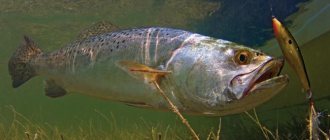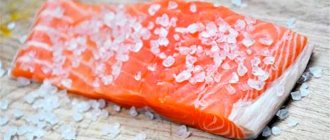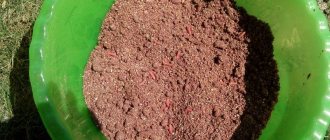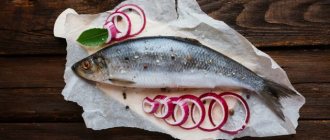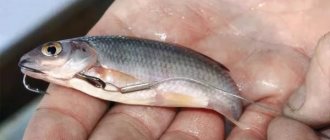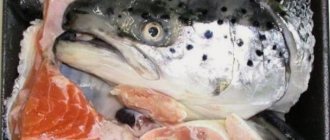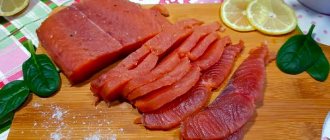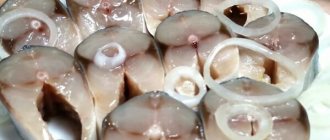- November 1, 2018
- Cooking
Grayling is a fish of the salmon family. A resident of Siberian reservoirs has a particularly refined taste and is very popular among fishermen. A real fisherman should know how to pickle grayling - after all, this is an excellent snack, a tasty delicacy for the whole family.
Cooking features
- Fresh or chilled fish is always tastier than frozen, but if you do not have the opportunity to purchase fresh grayling for salting, frozen is also suitable for this purpose. It is important to allow this product to thaw in natural conditions, without exposing it to sudden temperature changes. An attempt to speed up the process of defrosting grayling using a microwave will lead to loss of moisture and disruption of its structure, causing it to become loose and dry. This will negatively affect the organoleptic qualities of the finished delicacy.
- When purchasing fresh grayling, you need to make sure it is fresh enough. The eyes of the fish should be clear, the gills should be bright, and when pressure is applied to the carcass, it should quickly restore its shape. When purchasing frozen fish, they evaluate not only its type, but also the type of packaging. If there is liquid, snow, or pieces of ice inside, this indicates that the product was not stored properly and that it has been defrosted, possibly more than once. This negatively affects not only the taste of the product, but also its safety.
- Grayling is a small fish, and small specimens (weighing up to 0.3-0.4 kg) can be salted whole. However, before salting, the fish must be washed, cleaned and gutted. If you leave the head, remove the gills. More often, grayling is salted in the form of steaks or fillets. The skin is usually not removed from the fillet. It is advisable to remove skin from grayling fillets if they are to be used for making sushi.
- The time for salting grayling depends on the composition of the brine or curing mixture, salting technology, and the desired result. It can range from 20 minutes to 2-3 days. In order to get the expected result, it is advisable to follow the recommendations accompanying the specific recipe.
Salted grayling can be served with potatoes as a main snack, or used for making sandwiches, salads, and other snacks. A good idea would be to include it in fish cuts.
Ambassador of grayling in its entirety
Lightly salted, fleshy grayling with boiled crumbly potatoes has an attractive taste. Grocery list for the recipe: 7 grayling carcasses, 3 bay leaves, 8 pp. l. finely chopped salt. You can salt the fish in the following steps.
It is best to use small-sized carcasses, which will cook quickly and evenly. Remove the fish specimens from the gills and rinse under running water so that no blood clots remain on the meat. Place the grayling on paper napkins, sprinkle the pulp and the bottom of the wooden mold with salt.
Place the carcasses on a layer of salt, evenly distributing the laurel leaves over the preparations. Cover the structure with a flat lid on top and place a bend on it. Leave the grayling in the cold so that the juice does not spill over the edge of the bowl. After a day, remove the plate, mix the pulp with salt juice and cover again with a lid with pressure.
After 3 hours, the carcasses acquire elasticity, the backbone becomes hard, and the surface of the fish remains shiny. Blot the finished fish with napkins, add pickled onion rings and a splash of lemon juice.
You cannot use previously prepared brine to re-salt fish, as bacteria and microbes develop in it.
How to salt grayling at home
You can prepare grayling using any well-known methods. However, true connoisseurs of fish know that it truly reveals its taste when it is salted. Despite the fact that it is much more convenient to salt grayling at home, if necessary, this can also be done outdoors.
Dry salting of grayling:
- 1 kg of grayling;
- 2 tbsp. l. salt;
- 1 tsp. ground black pepper;
- 2 onions;
- if you have spices, you can add cloves, bay leaves, etc.
Preparation:
- Like any river fish, grayling is covered with scales. It needs to be cleaned, as well as the head cut off and the entrails removed. Wash the fish, cut into portions, and place in a deep bowl.
- Peel the onion and cut it into rings or half rings. Add onion, salt, spices to the bowl and stir.
- Cover the bowl with cling film, or just a plate, and walk for 20-30 minutes. Yes, small grayling gets salted so quickly. During this time, the onion will release juice, dissolve the salt, and the grayling will be saturated with the aroma of spices, but will not lose its taste.
Some fishermen prefer to pickle grayling in a mixture of sugar and salt, topped with soy sauce. The pickling time is the same, but the taste is specific. Soy sauce “steals” the taste of the fish a little,” but everyone has their own taste.
Salting grayling using the dry method
Often, fishermen prepare salted grayling directly while fishing, using the “dry” cooking method. After cleaning, the fish is gutted. The insides along with the blood are removed and then wiped with a dry cloth.
A prerequisite is that the fish does not come into contact with water.
To make such salted grayling, the recipe requires mixed 2 tbsp. l. salt and one sugar. Having distributed the mixture in an even layer along the entire length of the carcass and inside it, place the fish in a saucepan or food tray, belly up. Grayling is kept in this state for about five hours.
The room should be cool. When salting several carcasses at the same time, it is necessary to put pressure on them. The salting process in this case can take about a day.
Grayling, salted whole
3
Compound:
- grayling – 1 kg;
- salt – 80-100 g;
- laurel leaves – 2 pcs.
Cooking method:
- Break the laurel leaves and grind them further using a pepper mill or coffee grinder. In the absence of these devices, the seasoning can simply be crushed.
- Mix bay leaves with coarse salt.
- Graylings are approximately the same size and weigh no more than 300-350 g; clean, gut and rinse. Remove the gills.
- Pour a couple of tablespoons of the salting mixture into the bottom of an enamel pan or food-grade plastic or glass container and spread it over the bottom.
- Rub the grayling carcasses inside and out with salt and place in a prepared container.
- Sprinkle the fish with the remaining salt. Cover it with gauze, then with a plate or flat lid of a smaller diameter than the container chosen for salting grayling.
- Place a small weight on top. It can be a liter jar filled with water.
Place the container with grayling in a cool place. It will be ready to eat in 2-3 days, depending on how large the carcasses you took.
Salting recipes
On the Internet you can find many recipes to help salt fish, but not all of them help preserve the taste of the product, giving the meat the desired structure and maintaining fat content.
If the fish is supposed to be stored for a long time, then traditional methods are more suitable, but if the fish is supposed to be eaten immediately after cooking, then it is realistic to use spicy salting.
Dry (traditional) method
The traditional or classic method of salting is carried out in a deep container, with holes, made of wood. It is permissible to use a box made from ordinary boards as a container. You should also stock up on a linen bag, coarse rock salt, and fish (prepared).
Tips for fisherman: How to tie a fly to a fishing line for grayling - Let's take it step by step
The bag is placed on the bottom of the box, and then the fish is laid out and salted.
On a note! If you crush the fish under pressure, then between the fish carcasses there will be no voids in which bacteria can develop. In addition, oppression makes the meat structure more dense.
In this state, the fish is left for a week and a half, in a cool, dark place. The juice that begins to secrete will come out through the holes.
At the end of the salting process, they begin the process of soaking the fish and further drying it.
Wet method or salting in brine
To do this, you will have to find a suitable container that does not support oxidation processes. A plastic bucket is suitable for this, but it must be made of food-grade plastic or an enamel bucket (saucepan), etc. After this, the fish is tightly placed in a container with its belly up and sprinkled with salt. For 10 kg of fish you will need 1 kg of salt.
On a note! If you add no more than 30 g of sugar for every kilogram of salt, the fish meat will taste more tender.
Just as in the first case, the fish should be pressed down with a lid with a weight (pressure). Somewhere on the 2nd day, the fish begins to release juice, which combines with salt. The result is a brine in which the fish will remain for up to 10 days, which depends on the size of the fish: the larger the carcasses, the more time is needed for them to be well saturated with the marinade.
After this period, the fish is taken out and washed in running water, after which the fish is ready for the next stage - the drying or drying stage.
Preparing brine is not difficult if you dissolve 1 kg of salt in 3 liters of water. After this, the fish is filled with the resulting brine and aged for up to 8 days. The fish, as in the first case, must be covered with oppression and placed in a cool place.
Spicy salting method
The correct salting process comes down to preparing the brine, as in the previous case, and then adding spices to it, in the form of bay leaves, black peppercorns, horseradish leaves and coriander (in any form). If you add a little sugar, it will not worsen the taste of the product.
The fish should be placed in an enamel container and filled with brine. Without fail, the fish is covered with oppression. After this, the fish is left for a couple of days.
After this process, it is better to dry the fish a little, which will increase the shelf life of the fish in the refrigerator, and will also allow you to get a brighter taste.
Hanging method
This salting method is mainly used for fatty fish. Fish carcasses are strung on a transverse rod through the gills and placed in a container with brine. Moreover, the fish should be in a suspended state. Water and salt are used as brine without adding other components. The amount of salt is determined as follows: a raw egg or potato is placed in the brine. If they do not sink, then the brine is of the required concentration.
The salting process lasts 4-6 days. Naturally, it is difficult to determine exactly how long it takes for the carcasses to be saturated with brine without gaining excess salt. As a result, many people overexpose their fish. As a result, the fish then has to be soaked, and longer than usual.
Salmon method for fresh fish
Mackerel or herring are usually salted in this way. Before salting, the fish is cut and generously sprinkled with salt around the belly, as well as on the back. It is better to add 10 grams of sugar and spices to the salt, in the form of bay leaves or black peppercorns. After this, the fish is wrapped in linen or cotton cloth, after which the fish is placed in the refrigerator.
After this, the fish is kept in the refrigerator for up to 30 hours, and then the fish is taken out and dried laid out on a flat surface. At the same time, some people begin to eat fish without drying it.
Preparing the fish
Before salting fish, the carcass must be prepared. There are many methods of salting, but for any of them the fish must be cleaned. Cut off the head of the grayling, remove the entrails and, if desired, remove the scales. Rinse the carcass thoroughly under running water.
For salting, use only fresh fish; most fishermen prefer to salt grayling directly while fishing, as this product quickly deteriorates. Frozen grayling is also suitable, but if properly defrosted - at room temperature.
To make the salted fish look attractive, it is better to cut the carcass into small pieces before cooking.
This is interesting: Lightly salted taimen
What to salt
In restaurants and at home, red fish is usually salted. She is easy to work with, she is gentle. Salmon, sockeye salmon, and trout are ideal for salting. Pink salmon has a slight metallic taste, not everyone likes it; chum salmon also gives a rather harsh taste when salted. Chinook salmon is too small and inconvenient for salting. Mostly sea fish is salted, it is fattier, salt draws moisture out of the fish when salting, and this is where fat is needed so that the fish remains tender and tasty.
But in nature, we often salt river white fish. Absolutely any.
1. I try to carefully kill the fish as soon as possible, I don’t let it fight. Naturally, immediately remove the carcass in the shade, do not crush it, and do not severely damage the scales. Fish that has beaten, wrinkled places on the carcass, large areas of torn scales, especially tender and fatty ones, in my opinion, lies much worse. Dead fish should not have any contact with water. I completely agree with you on this.
1. I try to carefully kill the fish as soon as possible, I don’t let it fight. Naturally, immediately remove the carcass in the shade, do not crush it, and do not severely damage the scales. Fish that has beaten, wrinkled places on the carcass, large areas of torn scales, especially tender and fatty ones, in my opinion, lies much worse. Dead fish should not have any contact with water. I completely agree with you on this.
Tips for fisherman: Fishing for grayling in Siberia in winter - Let's take it step by step
2. Gut it quickly if possible. The sooner, the better. Naturally, I clean the kidneys (in my opinion, it’s easier and faster with a fingernail than with a spoon

